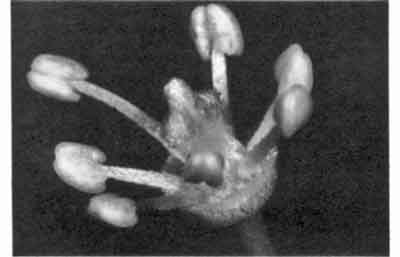
WHAT AFFECTS LYCHEE FRUIT SET?
SCIENTIFIC NAME: Litchi chinensis
FAMILY: Sapindaceae
Lychee trees are noted for low and irregular yields. Mature Tai So trees in southern Queensland average as little as 20 kg per tree but are capable of up to 150 kg.
The low yields are mainly due to poor flowering caused by excessive vegetative growth in autumn. In some seasons, trees flower well but fruit set is still low. This is because the trees produce too many male flowers and not enough female flowers. Only female flowers set fruit. Unfortunately, not all fruit set will reach maturity.
Fruit drop starts soon after fruit set and peaks two to four weeks later. Smaller amounts will continue to drop right through to harvest. Best yields will occur in cultivars with a good proportion of female flowers and the ability to retain fruit.

FLOWERING PATTERN
Flower panicles start to appear in late autumn to early winter and flowers open two to four months later. Exact emergence times vary with temperature and cultivar.
TEMPERATURE EFFECTS
The sex of flowers is decided well before they open. Day temperatures of 26 degrees C and above during the period five to seven weeks before flowering increase the proportion of male flowers.
Female flowering is favoured by temperatures of 19 degrees C and below during the same period.
Lychee male flower. Some cultivars produce
nearly all male flowers in some seasons.
High day and night temperatures just as the panicles start to emerge can cause panicles to stop flowering and produce leaves. At the same time, more male flowers are produced and the number of female flowers decline.
Wai Chee produces good numbers of female flowers as long as the day and night temperatures are below 30 degrees C and 25 degrees C respectively.
Other popular cultivars, including Tai So, Bengal, Souey Tung and Kwai May Pink, only produce satisfactory female flowering when the day/night temperature range is below 25/20 degrees C or even 20/15 degrees C.
WATER EFFECTS
If irrigation is stopped in late autumn and it doesn't rain, leaf growth will stop and flowering will improve. Once the flower panicles start to emerge, water should be applied at maximum rates to avoid stress and minimise fruit drop. If stressed at this time, flowers dry out and fall. Female flowers are particularly affected. The few flowers remaining will be male.
PANICLE REMOVAL
In China, early flowering panicles are sometimes removed. Panicles which appear subsequently have more female flowers and better fruit set.
The effects of panicle removal and its timing were investigated in a trial on Tai So trees in the Nambour district. Tai So was used as it often produces panicles from late April onwards under warm southern Queensland conditions.
These panicles have few, if any, female flowers and fruit poorly. As long as panicles were removed before they were five centimetres long, the branch would flower again.
The new panicles which followed had more female flowers and set more fruit. If panicles were allowed to grow longer before removal, fewer replacement panicles were produced. Most of those that did appear carried leaves rather than flowers.
This system will produce higher yields, but labour costs make it prohibitive. Treating any but the smallest trees is impractical.
CONCLUSION
Many lychee cultivars are not reaching their potential under southern Queensland conditions.
Only cultivars with a good proportion of female flowers and good fruit retention will yield well. Cultivars producing panicles under cooler winter day temperatures produce more female flowers.
In contrast, early flowering Tai So trees in warm districts produce very few female flowers.
Water stress soon after panicle emergence reduces female flowers and potential yield. Growers should irrigate their trees using maximum rates, from panicle emergence until the trees flush after harvest.
Removing early panicles at the appropriate time will increase yields. This practice is impractical on all but the smallest trees.
DATE: July 1991
* * * * * * * * * * * * *
